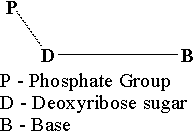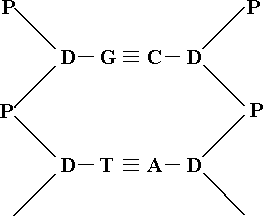Education Links
Leaving Cert
 Maths
Maths
 French
French
 English
English
 Chemistry
Chemistry
 Physics
Physics
 Biology
Biology
 Economics
Economics
 Spanish
Spanish
 Geography
Geography
 History
History
Junior Cert
Genes
- A gene is the unit of inheritance.
- Genes are made of DNA (except in some viruses it is RNA)
- Genes carry the code for the production of protein.
Structure of DNA (Deoxyribonucleic Acid)
The complete structure of the DNA molecule was put forward by Francis Crick and James Watson in 1953. Their findings were based on the earlier studies of Rosalind Franklin (1920 - 1958).According to Watson and Crick, DNA is built like a ladder twisted on itself or like a double spiral staircase. This shape is called the double helix.
DNA is a large molecule composed of a series of sub units called nucleotides.
Each nucleotide consists of three units:
(i) A sugar molecule
(ii) A phosphate group
(iii) One of four different nitrogen containing compounds called bases.
The four bases are Adenine (A), Thymine (T), Guanine (G) and Cytosine(C).
 The deoxyribose molecule occupies the centre position of the nucleotide with the phosphate group on one side and a base on the other.
The deoxyribose molecule occupies the centre position of the nucleotide with the phosphate group on one side and a base on the other.The nucleotides join together with a bond between the phosphate group of one nucleotide and the sugar of the next. The linked sugar and phosphate sub units form the side rails of the ladder. The bases face inwards forming the rungs of the ladder. The bases are held together by hydrogen bonds.
Adenine forms two hydrogen bonds with Thymine and Guanine forms three hydrogen bonds with Cytosine.

P - Phosphate group, D - Deoxyribose sugar, G - Guanine, C - Cytosine, T - Thymine, A - Adenine.
Guanine always bonds to Cytosine. Adenine always bonds to Thymine.
Differences between DNA And RNA
DNA1. Contains the sugar deoxyribose
2. The bases are Adenine, Thymine, Guanine and Cytosine
3. Double stranded (double helix)
4. Found in the nucleus
RNA
1. Contains the sugar ribose
2. The bases are Adenine, Uracil, Cytosine and Guanine
3. Single stranded
4. Found in the nucleus and the cytoplasm
Protein Synthesis
Proteins are composed of amino acids and the structure and function of a protein is determined by the sequence of its amino acids. The sequence of amino acids is determined by the sequence of the bases in the DNA.- The double helix unwinds and the two sides of the chain separate.
Click here for a diagram. - Each sequence of three bases along one of the strands is called a codon.
- RNA nucleotides form base pairs with one strand of the DNA (called mRNA, messenger RNA). This process is called transcription.
Click here for a diagram. - The mRNA passes out of the nucleus into the cytoplasm.
- The mRNA attaches to the ribosomes.
- The cytoplasm has a supply of RNA molecules, which carry three bases at one end and a specific amino acid on the other. This type of RNA is called transfer RNA (tRNA).
- If the bases on the tRNA are complimentary to those on the mRNA it attaches briefly.
- The amino acids on the tRNA molecules join together to form a protein.
Click here for a diagram. - The process of building a protein from the instructions of mRNA is called translation.
DNA Replication
This occurs during interphase of mitosis and meiosis.- The hydrogen bonds between the base pairs break and the two chains of the double helix unwind so those complementary bases are exposed.
Click here for a diagram. - Free nucleotides (always present in the cytoplasm) move into the nucleus. These nucleotides attach to the exposed bases to form new base pairs.
Click here for a diagram. - Each new strand is made up of half-old DNA and half-new DNA.
- The two new strands are identical to each other and to the original strand of DNA.
Click here for a diagram.
 |
Experiment To test for DNA |
Mutations
A mutation is a change in genetic make up.There are two main types:
1. Gene Mutations (point mutations):
This is a change in a single gene. Examples include:
- Haemophilia (the inability of the blood to clot properly).
- Sickle cell anaemia (the production of insoluble haemoglobin).
2. Chromosome Mutations
[A] Change in chromosome structure:
a. Inversion:
This is when part of the chromosome breaks off, turns around, rejoins the chromosome again. This results in the sequence of the genes being reversed.
b. Translocation:
This is a change of genes between non-homologous chromosomes.
c. Deletion:
This is when part of a chromosome is lost.
[B] Change in chromosome number:
a. Addition or loss of one or more individual chromosomes.
This can occur during anaphase 1 of meiosis when two homologous chromosomes do not separate. As a result one of the daughter cells will have an extra chromosome while the other will be missing a chromosome. Humans normally have 46 chromosomes in each non-reproductive cell - 44 autosomes and 2 sex chromosomes. If they gain an extra chromosome they will have 47 while if they loose a chromosome they will have 45.
Example:
(i) Down's syndrome:
This is caused by an extra number 21 chromosome (47 chromosomes instead of 46). The symptoms include a skin fold in the inner corners of the eyes, small hands and fingers, large tongue and inadequate development of the brain.
(ii) Turner's Syndrome:
This is caused by the loss of an X-chromosome (45 chromosomes instead of 46). Females may suffer physical and sexual abnormalities.
b. Addition or loss of a complete set of chromosomes.
A gain of a whole set of chromosomes is called polyploidy. A polyploid cell has more than two of each chromosome.
Causes of Mutations
Mutagens are agents, which speed up mutations. A mutagen, which causes cancer, is called a carcinogen.
The main mutagens are:
1. Radiation, such as:
- X-rays
- Gamma rays
- Ultraviolet light
- Benzene
- Formaldehyde.
- Thiotepa (textile industry)
- Mutations are an important source of genetic variation. The new genes may show an improvement on the original ones.
- If a mutation occurs in a normal body cell it may give rise to cancer. When the individual dies the mutation disappears too i.e. the mutation is not inherited.
- If the mutation occurs in a gamete-producing cell the mutation may be past on to the next generation.


